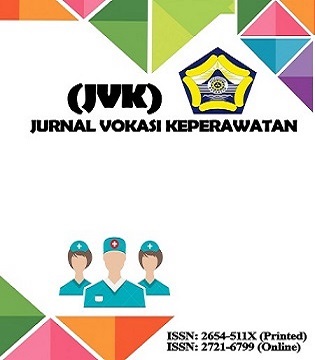Main Article Content
Abstract
Depression is a psychological disease that is rarely detected but can directly reduce the quality of life of sufferers, especially the elderly. The purpose of this study was to describe the level of depression in the elderly in the working area of the outpatient sidomulyo health center. Descriptive analytic research design with a purposive sampling approach, the study was located in the working area of the sidomulyo outpatient health center in pekanbaru city with 100 elderly respondents aged over 60 years. The measuring instrument is the geriatic depression scale (gds) questionnaire which has been tested for validity and reliability. The description of the level of depression in the elderly in the working area of the sidomulyo health center can be concluded that the highest level of depression is mild depression (40%), while the characteristic results show that the most age is 60-69 years (56%), the sex of the majority is female (60 %), the majority last education was high school (30%), married status, most of them don't have a partner/not married (55%), and the majority of respondents don't work anymore (61%), and most of the elderly have physical health problems (74%). It was found that the highest levels of depression were mild depression (40%), moderate depression (38%), severe depression (4%), and those who did not experience depression (18%), so that the level of depression in the elderly in the work area outpatient sidomulyo health center with the most mild depression category. Future researchers, it is hoped that they can develop research with more samples and look for risk factors associated with depression in the elderly.
Keywords
Article Details
Copyright (c) 2023 Fikri Erwanto , Herlina , Aminatul Fitri

This work is licensed under a Creative Commons Attribution-ShareAlike 4.0 International License.
Authors retain copyright and grant Jurnal Vokasi Keperawatan (JVK) right of first publication with the work simultaneously licensed under a Creative Commons Attribution-ShareAlike 4.0 International (CC BY-SA 4.0) license, that allows others to freely share and remix the work with an acknowledgement of the work's authorship and initial publication in jurnal vokasi keperawatan (JVK).References
- Livana Ph, Susanti Y, Darwati Le, Anggraeni R (2018). Gambaran Tingkat Depresi Lansia. Jurnal Keperawatan Pemikiran Ilmiah. ;4(4):80 -93
- Aryawangsa, A., G., N., Ariastuti, N., L., P. (2016) Prevalensi Dan Distribusi Faktor Risiko Depresi Pada Lansia Di Wilayah Kerja Puskesmas Tampaksiring I Kabupaten Gianyar Bali. Jurnal Isainmedis, Ism Vol. 7 No.1, September-Desember, Hal 12-23
- Suardana, I.W (2011). Hubungan Faktor Sosiodemografi, Dukungan Sosial, Dan Status Kesehatan Dengan Tingkat Depresi Pada Agregat Lanjut Usia. Majalah Kedokteran Indonesia, 57(7):233-8.
- Anissa, M., Amelia, R., Dewi, N. P. (2019) Gambaran Tingkat Depresi Pada Lansia Di Wilayah Kerja Puskesmas Guguak Kabupaten 50 Kota Payakumbuh. Health And Medical Journal, Vol 1, No 2 Https://Jurnal.Unbrah.Ac.Id/Index.Php/Heme/Article/View/235
- Kurniawan, D. B, Murhayati, A, Saelan (2016) Gambaran Tingkat Depresi Lansia Di Wilayah Kerja Pukesmas Sibela Surakarta. N Universitas Kusuma Husada Surakarta
- Kementerian Kesehatan Ri Badan Penelitian Dan Pengembangan. (2020). Hasil Utama Riset Kesehatan Dasar. Kementrian Kesehatan Republik Indonesia
- Raudhoh, N (2017) Lansia Asik. Lansia Aktif, Lansia Produktif. Jurnal Pengabdianmasyarakat Https://Doi.Org/10.22437/Medicaldedication.V4i1.13458
- Sari, D. M. (2016). Hubungan Pola Komunikasi Keluarga Dengan Tingkat Depresi Lanjut Usia.
- Utami, A. W., Liza, R. G., & Ashal, T. (2018). Hubungan Kemungkinan Depresi Dengan Kualitas Hidup Pada Lanjut Usia Di Kelurahan Surau Gadang Wilayah Kerja Puskesmas Nanggalo Padang. Jurnal Kesehatan Andalas, 7(3), 417–423. Retrieved From
- Made, S., C., S., Putrawan, I. B., & Rai, N. K. (2019). Hubungan Tingkat Inkontinensia Urin Dengan Derajat Depresi Pada Pasien Lanjut Usia Di Panti Sosial Tresna Werdha Wana Seraya Denpasar. Jurnal Medika Udayana. 8(8)
- Dewi, S. R. (2014). Buku Ajar Keperawatan Gerontik. Yogyakarta: Deepublish
References
Livana Ph, Susanti Y, Darwati Le, Anggraeni R (2018). Gambaran Tingkat Depresi Lansia. Jurnal Keperawatan Pemikiran Ilmiah. ;4(4):80 -93
Aryawangsa, A., G., N., Ariastuti, N., L., P. (2016) Prevalensi Dan Distribusi Faktor Risiko Depresi Pada Lansia Di Wilayah Kerja Puskesmas Tampaksiring I Kabupaten Gianyar Bali. Jurnal Isainmedis, Ism Vol. 7 No.1, September-Desember, Hal 12-23
Suardana, I.W (2011). Hubungan Faktor Sosiodemografi, Dukungan Sosial, Dan Status Kesehatan Dengan Tingkat Depresi Pada Agregat Lanjut Usia. Majalah Kedokteran Indonesia, 57(7):233-8.
Anissa, M., Amelia, R., Dewi, N. P. (2019) Gambaran Tingkat Depresi Pada Lansia Di Wilayah Kerja Puskesmas Guguak Kabupaten 50 Kota Payakumbuh. Health And Medical Journal, Vol 1, No 2 Https://Jurnal.Unbrah.Ac.Id/Index.Php/Heme/Article/View/235
Kurniawan, D. B, Murhayati, A, Saelan (2016) Gambaran Tingkat Depresi Lansia Di Wilayah Kerja Pukesmas Sibela Surakarta. N Universitas Kusuma Husada Surakarta
Kementerian Kesehatan Ri Badan Penelitian Dan Pengembangan. (2020). Hasil Utama Riset Kesehatan Dasar. Kementrian Kesehatan Republik Indonesia
Raudhoh, N (2017) Lansia Asik. Lansia Aktif, Lansia Produktif. Jurnal Pengabdianmasyarakat Https://Doi.Org/10.22437/Medicaldedication.V4i1.13458
Sari, D. M. (2016). Hubungan Pola Komunikasi Keluarga Dengan Tingkat Depresi Lanjut Usia.
Utami, A. W., Liza, R. G., & Ashal, T. (2018). Hubungan Kemungkinan Depresi Dengan Kualitas Hidup Pada Lanjut Usia Di Kelurahan Surau Gadang Wilayah Kerja Puskesmas Nanggalo Padang. Jurnal Kesehatan Andalas, 7(3), 417–423. Retrieved From
Made, S., C., S., Putrawan, I. B., & Rai, N. K. (2019). Hubungan Tingkat Inkontinensia Urin Dengan Derajat Depresi Pada Pasien Lanjut Usia Di Panti Sosial Tresna Werdha Wana Seraya Denpasar. Jurnal Medika Udayana. 8(8)
Dewi, S. R. (2014). Buku Ajar Keperawatan Gerontik. Yogyakarta: Deepublish
